Types of Hollyhock Plants: Flowers, Leaves, Seeds (Pictures) – Identification Guide

Hollyhock (alcea rosea) is a species of flowering garden plants with colorful white, purple, pink, red, and yellow cup-shaped flowers growing on tall spikes. Hollyhock flowers have a long blooming season, and their tall growth makes them useful landscaping plants. Easy to grow from seed, hollyhocks grow as short-lived perennials or biennials. Their brightly colored flowers make them ideal low-maintenance landscape plants for cottage gardens, mixed flower beds, or to create a colorful flowering living fence.
Although hollyhocks are easy to grow in the garden, they can be affected by hollyhock rust—a type of fungal foliage disease. However, with proper care, you can easily enjoy the beautiful pastel shades of hollyhock flowers in your summer garden.
This article is a complete guide to growing various types of hollyhocks. In addition, descriptions and pictures of hollyhock flowers will help you choose the best plants for your garden landscape.
Hollyhock Facts
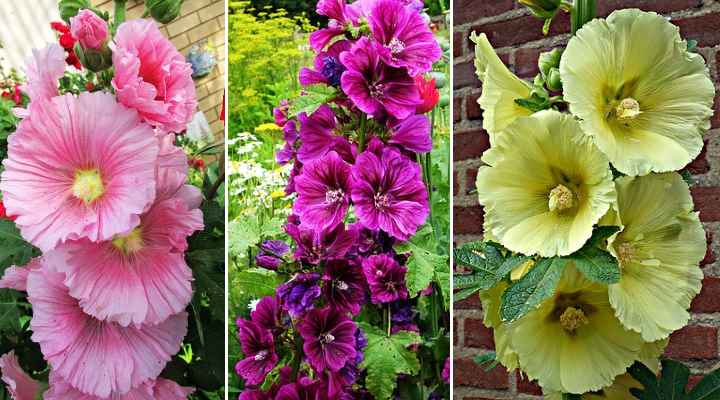
Since hollyhock plants are tall, they are suitable for growing at the back of flower beds or along walls
Hollyhock is the common name of plants in the genus Alcea and family Malvaceae. The tall, erect plants are identified by light green, round, lobed leaves growing on the end of long stems. The attractive feature of hollyhocks is the colorful cup or funnel-shaped flowers growing solitary or in clusters.
Hollyhocks thrive in gardens and containers in USDA zones 3 to 9. Depending on the climate, hollyhock plants grow as annuals, biennials, or short-lived perennials. However, most hollyhock varieties are biennials. This means they have a two-year life cycle—foliage grows during the first year, flowers appear in the second year, and then the plant dies.
Some hollyhocks grow as perennials because they are self-seeding. As one plant dies, the seeds that have dropped to the ground start growing. Their rapid growth means the flowering hollyhock plants reach maturity in a single season.
Hollyhocks reproduce through seeds. The reseeding takes place when seeds drop from spent flowers. The Alcea plants die back in the winter. In warm climates, hollyhocks will bloom year after year if you cut the stalks back to the ground and protect the roots from frost. In cold climates, you can grow hollyhocks as annuals.
Hollyhock flowering spires grow between 5 and 9 ft. (1.5 – 2.7 m) tall. The vibrant pink, white, red, yellow, or purple flowers look like hibiscus flowers or Rose of Sharon flowers. Dozens of flowers can grow on a single stalk, and the flowering part of the stalk can measure up to 2 ft. (0.6 m).
Due to their tall height, hollyhocks are ideal for growing at the back of flower beds, along fences and walls, or staked to prevent the long stalks from snapping in the wind.
Hollyhock Flowers
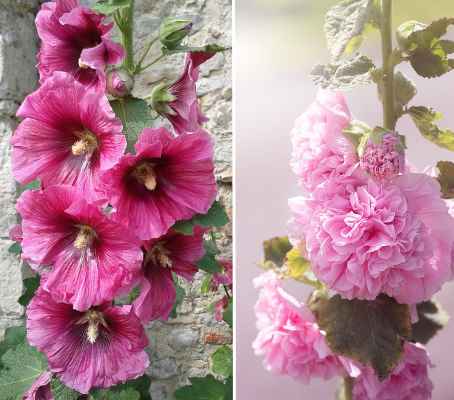
Hollyhock flowers can be single or double blooms
Hollyhock flowers are identified by cup-shaped vibrant blooms that are single or double-flowered varieties. The beautiful flowers grow 3” to 4” (7.5 – 10 cm) across. Flowers growing on hollyhock plants can be shades of pink, red, yellow, purple, and white. There is also a spectacular hollyhock plant with black flowers.
In most varieties, hollyhock flowers grow along the length of the upright stems. On some types, only the top 24” (60 cm) of the stalk blooms. The tall tapering flowering spires create dramatic, colorful backdrops in summer gardens.
When Do Hollyhocks Bloom?
Hollyhock flowers bloom during the warm summer months from June until August. Because hollyhocks grow as biennials, the flowers bloom during the second year of growth. Deadheading can help to extend hollyhock’s blooming season. By removing spent flowers, you can enjoy the spectacular flowers through fall and until the first frost.
Hollyhock Seeds
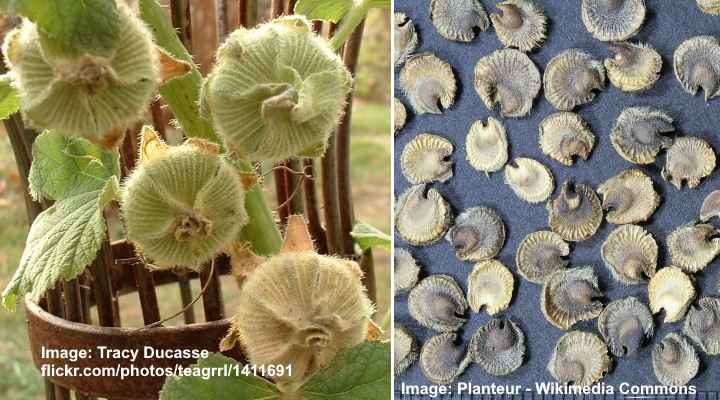
Hollyhock seed pods (left) and seeds (right)
Hollyhocks self-seed, or you can harvest the seeds from dried-out flowers from the start of August. Hollyhock plants are easy to grow from seeds. Start the seeds indoors about six to nine weeks before the last frost date. Growing in a moist, well-draining potting mix will take about 14 days for the seeds to germinate.
After the risk of frost has passed, you can plant germinated hollyhock seedlings in a sunny part of your garden.
Hollyhock Leaves

Hollyhock leaves
Hollyhock leaves are large, rounded leaves in a palmate or scalloped shape with five to seven lobes. Leaves on hollyhock plants measure 2” to 3” (5 – 7.5 cm) across. An identifying feature of hollyhocks is the large round leathery leaves growing on long stems (petioles).
A common issue with hollyhock leaves is brown-orange leaf spots called hollyhock rust. This fungal disease typically occurs if there is too much moisture in the ground or extremely humid conditions. In addition, hollyhock rust foliage damage can occur due to poor air circulation if the plants grow too close together.
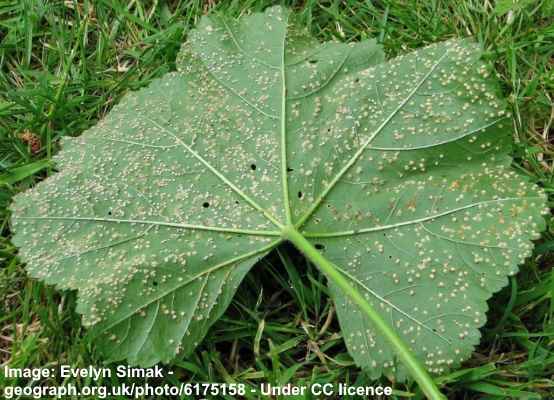
Hollyhock rust
Growing Hollyhocks
Hollyhocks (Alcea rosea) are impressive flowering plants that are easy to grow in your front or backyard. The two most essential aspects when growing hollyhocks is plenty of sunshine and fertile, moist, well-draining soil. After planting, hollyhocks require minimal care to bloom throughout the summer until fall.
How to plant hollyhock seeds: Sow hollyhock seeds in a light, soilless potting mix (perlite, vermiculite and peat moss are ideal) indoors about nine weeks before the last frost date. The seedlings take two weeks to germinate and should grow for at least another five weeks indoors.
Alternatively, you can plant hollyhock seeds directly in the ground a week before the last frost date. Put the seeds 1” (2.5 cm) in the soil and plant 3” to 6” (7.5 – 15 cm) apart.
When to plant hollyhock seeds in the ground: When starting seeds indoors, transfer hollyhocks to the garden after the risk of frost has passed. Plant the small plants 2 ft. (60 cm) apart to allow plenty of air circulation. During the first year, the biennials will grow tall and develop foliage. Blooming takes place the following year.
Where to plant hollyhock flowers: Hollyhock plants grow best in full sun but can tolerate light shade. The plants are relatively drought tolerant but grow best in moist soil. Due to their height, it’s vital to protect them from wind damage. The best place to plant hollyhocks is along a fence, wall or provide support with stakes.
To prevent hollyhock rust, it’s best to plant the flowers between 1 and 2 ft. (0.3 – 0.6 m) apart. This allows for plenty of air circulation and prevents humidity from destroying the foliage’s appearance.
Growing Hollyhocks in Containers
Hollyhocks grow well in containers if the container is large enough. A large barrel-like container should be sufficient for tall varieties. For dwarf hollyhock plants, choose a container 16” (40 cm) deep and 24” (60 cm) in diameter. Hollyhocks have an extensive taproot system that needs room to grow.
For hollyhock plants to thrive in containers, using a loose, well-drained potting mix is vital. A suitable soil for potted hollyhocks is a combination of one part peat moss, one part loamy soil, and one part perlite. This potting mix ensures adequate moisture retention and excellent drainage.
Top tip for growing hollyhock in containers: Remember that potted hollyhock plants require more frequent watering than those growing in the ground.
Types of Hollyhock Flowers (With Pictures)
Let’s look in more detail at some of the best examples of hollyhock flowers. Pictures and descriptions of the round, cup-like vibrant flowers will help you choose the best tall flowering landscaping plants for your garden.
Hollyhock ‘Blacknight’ (Alcea rosea ‘Blacknight’)
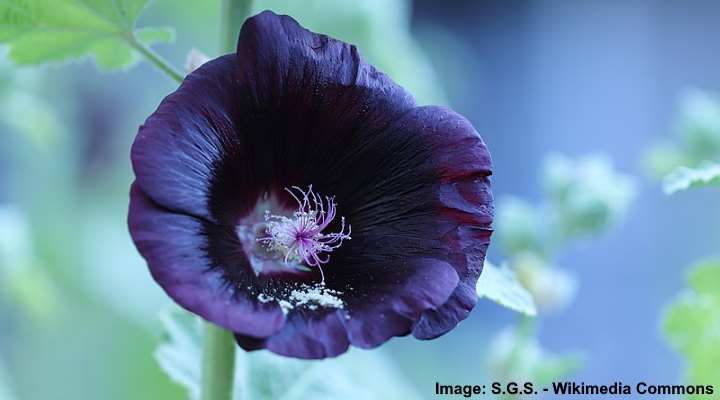
Hollyhock ‘Blacknight’ gives dramatic look to a landscaped garden
Hollyhock ‘Blacknight’ has dramatic black, funnel-shaped flowers growing on tall, erect spikes. ‘Blacknight’ hollyhock flowers are single blooms with papery deep purple-black petals. The spectacular black flowers measure 4” (10 cm) across and grow around the 6-foot (1.8-m) tall flowering stem. This hollyhock species grows 2 ft. (0.6 m) wide.
Hollyhock ‘Blacknight’ belongs to the Spotlight hollyhock series. These tall plants grow as tender perennials or annuals, not biennials, and self-seed in the garden. The delightful cottage garden flowers thrive in USDA zones 3 to 9 and grow best in full sun.
Hollyhock Flower Bloom Time: Mid to late summer
Hollyhock Flower Color: Deep purple to black
Hollyhock ‘Mars Magic’
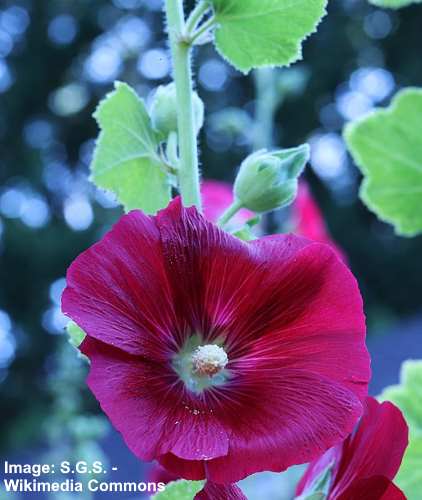
Hollyhock ‘Mars Magic’ with its beautiful red flowers is ideal plant along walls and fences
‘Mars Magic’ hollyhock has brilliant red funnel-shaped flowers with pale yellowish center. The papery hardy hibiscus-like flowers measure 4” (10 cm) across and grow abundantly on tall flowering spikes. The cup flowers are single blooms growing from the base of the flowering stalk.
Hollyhock ‘Mars Magic’ is a vigorous perennial plant that grows 5 to 6 ft. (1.5 – 1.8 m) high and 2 ft. (60 cm) wide. As with many varieties of hollyhock, its self-seeding nature can become invasive in some places.
Hollyhock ‘Mars Magic’ belongs to the Spotlight hollyhock series.
Hollyhock Flower Bloom Time: Mid to late summer
Hollyhock Flower Color: Vibrant bright red
Hollyhock ‘Halo Cerise’
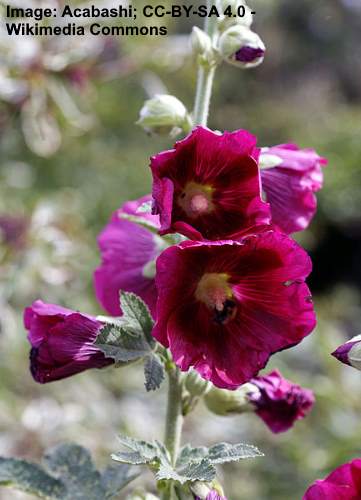
Alcea rosea’ Halo Cerise’
Hollyhock ‘Halo Cerise’ has beautiful deep pink flowers shaped like an open funnel. The name of this Alcea rosea hollyhock—‘Halo Cerise’—comes from the halo-like cerise pink margin of the petals and the deep purple center. The best place to plant these flowers is along a wall or fence.
‘Halo Cerise’ hollyhock flowers grow 5 to 6 ft. (1.5 – 1.8 m) tall and 2 ft. (60 cm) wide.
Hollyhock Flower Bloom Time: Early to mid-summer
Hollyhock Flower Color: Cerise or magenta pink and dark purple
Hollyhock ‘Spring Celebrities Carmine Rose’
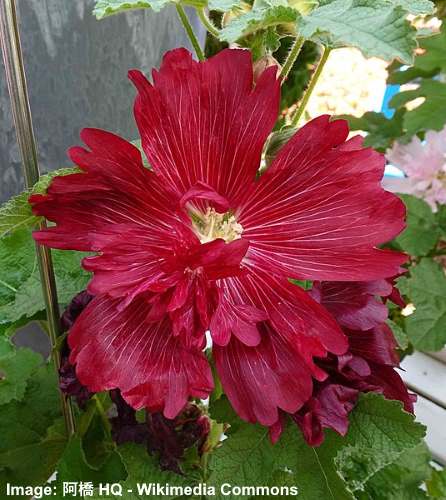
Althaea rosea ‘Spring Celebrities Carmine Rose’ has ruffled double flowers
Hollyhock flowers in the ‘Spring Celebrities’ series are some of the showiest flowers in the garden. The ‘Carmine Rose’ hollyhock variety has ruffled, double flowers that are a rosy-red color. The abundance of these frilly red flowers creates eye-catching floral spikes in garden landscapes.
Hollyhock ‘Spring Celebrities Carmine Rose’ is a short-lived perennial, low-growing plant that is 2 to 2.5 ft. (60 – 80 cm) tall and 1 to 1.5 ft. (30 – 45 cm) wide. This dwarf hollyhock is ideal for growing in containers or small, compact gardens.
Hollyhock Flower Bloom Time: Mid to late summer
Hollyhock Flower Color: Pinkish red
Hollyhock ‘Spring Celebrities White’
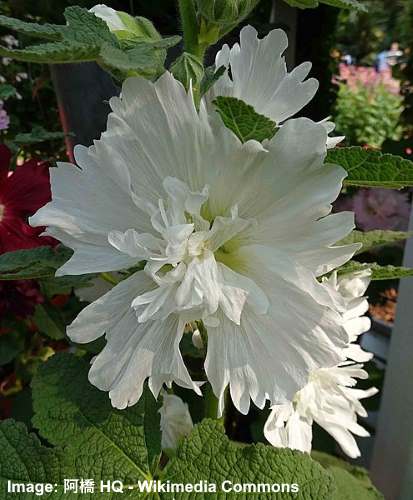
Hollyhock ‘Spring Celebrities White’
Hollyhock ‘Spring Celebrities White’ is a dwarf, short-lived perennial with showy snow-white flowers. The double blooms and ruffled petals look spectacular, contrasting with the large palmate to oval leaves. Prized for its short stature, this showy white hollyhock is perfect for growing in containers.
The white ‘Spring Celebrities’ hollyhock thrives in USDA zones 6 to 9. The flowering brilliant white flowering spikes mature at 2 to 2.5 ft. (60 – 80 cm) high and a spread of 1.5 ft. (45 cm) wide.
Hollyhock Flower Bloom Time: Mid to late summer
Hollyhock Flower Color: Brilliant white
Hollyhock ‘Spring Celebrities Purple’
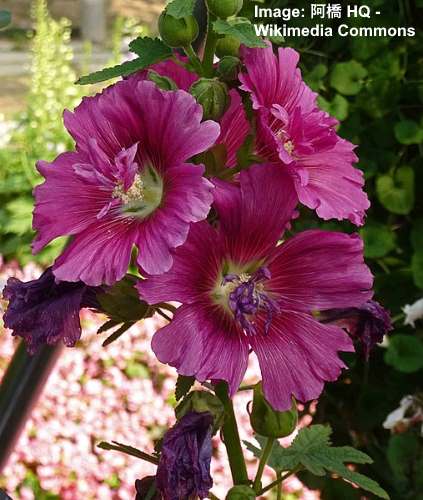
Hollyhock ‘Spring Celebrities Purple’
Hollyhock ‘Spring Celebrities Purple’ flowers are eye-catching showy purple flowers with five broad crepe-like petals and wavy edges. An unusual feature of the purple hollyhock flowers is the small petals growing from pale yellow stamens in the center.
Like other varieties of hollyhocks in the ‘Spring Celebrities’ series, the purple variety grows up to 2.5 ft. (80 cm) tall and 1.5 ft. (45 cm) wide. Plant in USDA zones 6 to 9 and full sun for this short-lived perennial to thrive.
Hollyhock Flower Bloom Time: Mid to late summer
Hollyhock Flower Color: Dark magenta to deep purple
Hollyhock Alcea rosea ‘Pleniflora’ Yellow
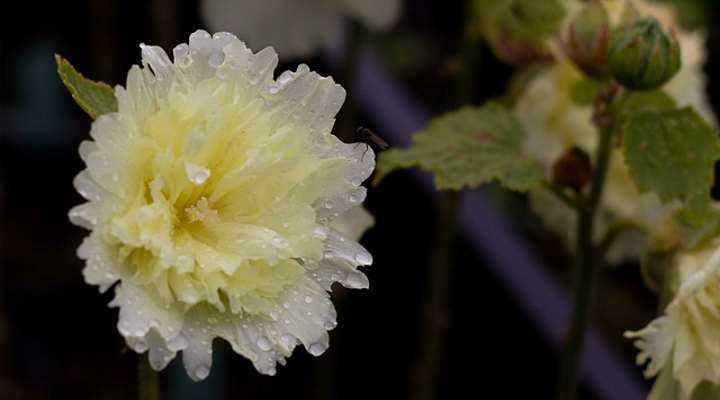
Alcea rosea ‘Pleniflora’ yellow
The yellow-flowered ‘Pleniflora’ hollyhock has showy double blooms with ruffled petals. Looking at pictures of the ‘Pleniflora,’ it’s easy to mistake them for showy yellow carnation flowers. However, the delightful blooms contrast with green, heart-shaped leaves. Grow this short-lived perennial in USDA zones 3 to 8 and full sun for best results.
‘Pleniflora’ hollyhocks grow up to 8 ft. (2.5 m) tall. Space the tall plants at least 2.2 ft. (0.7 m) apart when planting them in the garden. These flowers are ideal for cottage gardens, front gardens, or to hide a fence or wall.
Hollyhock Flower Bloom Time: Mid-summer
Hollyhock Flower Color: Bright yellow or pale yellow
Antwerp Hollyhock (Alcea ficifolia)
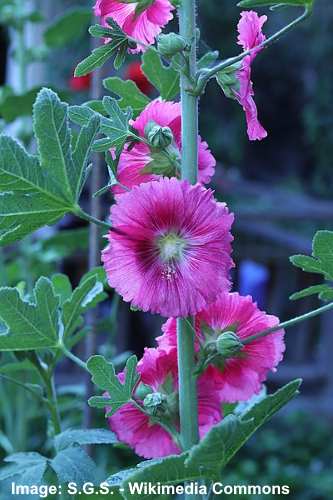
Antwerp hollyhocks come in a variety of colors
The Antwerp hollyhock is a beautiful example of a vigorous flowering plant for your garden. This biennial, short-lived perennial has showy, single blooms in peach, pink, yellow, and red colors. Grow the Antwerp hollyhock plant in USDA zones 3 to 10, where it reaches 8 ft. (2.4 m) tall and 2 ft. (0.6 m) wide.
The large lobed green leaves are rust-resistant and don’t succumb to fungal diseases. Therefore, this plant is also called the Antwerp Fig Leaf hollyhock.
Hollyhock Flower Bloom Time: Mid-summer to fall
Hollyhock Flower Color: Various shades of burgundy, peach, pink, red, and yellow
‘Chater’s Double’ Hollyhock Scarlet

‘Chater’s Double’ Hollyhock Scarlet
This spectacular back-of-the-border tall flowering hollyhock has deep red fluffy-looking double blooms. The extremely large, showy, ruffled, wine-red flowers contrast with the small lobed green leaves. The short-lived perennial grows as a biennial and reaches 7 ft. (2.1 m) tall and 18” (0.45 m) wide.
Hollyhock Flower Bloom Time: Mid-summer to early fall
Hollyhock Flower Color: Scarlet red
‘Chater’s Double’ Hollyhock White

‘Chater’s Double’ Hollyhock White
Hollyhock ‘Chater’s Double’ white variety has spectacular tall spikes filled with crepe-textured showy flowers. The double blooms create an elegant, romantic floral display and work well as cut flowers. Although this hollyhock variety is a short-lived perennial, its self-seeding nature means it will grow and bloom for many years.
Hollyhock Flower Bloom Time: Mid to late summer
Hollyhock Flower Color: Pure white
Indian Spring Hollyhock
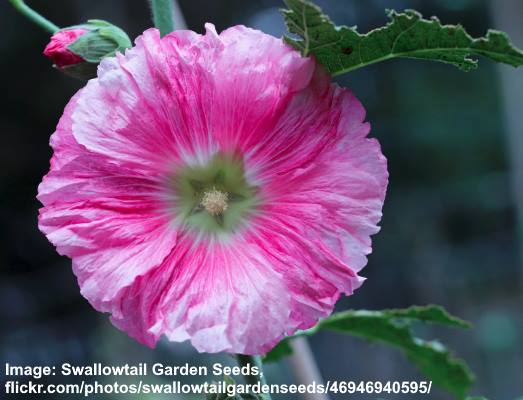
Indian Spring hollyhock
Indian Spring hollyhock grows stunning colorful disc-shaped flowers with crepe-paper petals and a star-shaped center. Unlike biennial hollyhocks, the Indian Spring blooms in its first season. The large bright pink, white, rose-salmon, or red petals attract pollinators when in bloom throughout the summer. The hollyhock flowers measure 2” to 4” (5 – 10 cm) wide.
Hollyhock Flower Bloom Time: All summer long
Hollyhock Flower Color: Pink petals with white shades, as well as other colors
Creme de Cassis Hollyhock
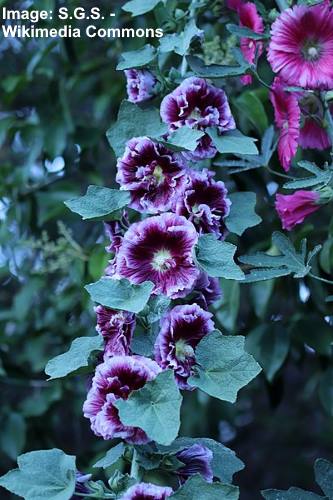
Creme de Cassis hollyhock
One of the most spectacular flowering hollyhocks is the ‘Creme de Cassis’ variety. The large oval, saucer-like purple flowers grow up to 4” (10 cm) wide and cover flower spikes measuring 4 to 6 ft. (1.2 – 1.8 m) tall. The attractive purple flowers have a pale purple or white ring margin, pale yellow center, and deep veining patterns.
Hollyhock Flower Bloom Time: Early summer until early fall
Hollyhock Flower Color: Purple and white flowers
Brilliant Miniature Hollyhock
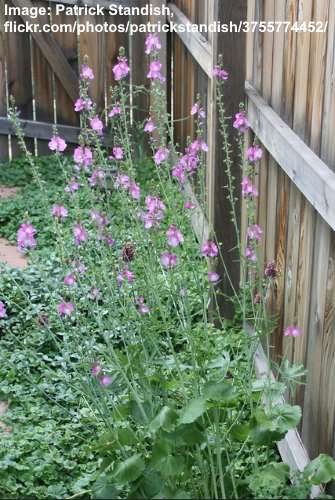
Brilliant miniature hollyhock
Miniature hollyhocks have abundant small cup-shaped flowers that have vibrantly colored five-petaled red, pink or purple flowers with yellow centers. The open petals have a satiny finish and seem to shine in full sun. These sturdy, short-growing flowering spikes grow around 40” (1 m) tall and don’t need spikes to grow erect.
Miniature hollyhocks are also called prairie mallows and have the botanical name Sidalcea hybrida. However, they get the common name hollyhocks for their resemblance to flowers in the genus Alcea. Ideal for planting in containers, borders, or mass plantings.
Hollyhock Flower Bloom Time: Early summer to early fall
Hollyhock Flower Color: Red and deep pink are the most popular colors
Pink Bristly Hollyhock (Alcea setosa)
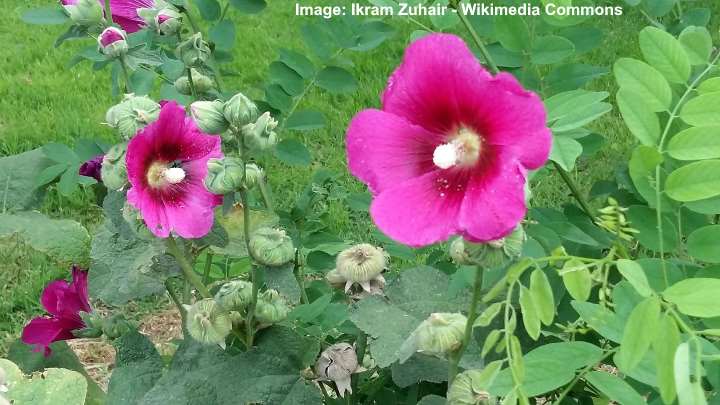
Pink Bristly Hollyhock (Alcea setosa)
Bristly hollyhock has magnificent pink funnel-shaped flowers growing on long, thin hairy stems. The long flowering stalks grow up to 10 ft. (3 m) tall. The open, light pink flowers have a deep pink to purple throat, making these flowers look like hardy hibiscus flowers. There is also a protruding yellow stamen in the flower’s center.
The common name of Alcea setosa comes from the bristly hairs that cover the stems and leaves.
Hollyhock Flower Bloom Time: From late spring until mid-summer
Hollyhock Flower Color: Pink, dark pink, and purple
‘Russian Beauty’ Hollyhock
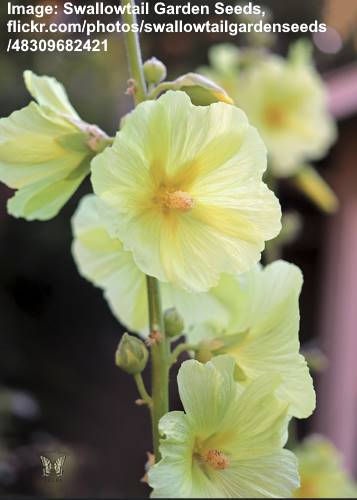
‘Russian Beauty’ hollyhock
‘Russian Beauty’ hollyhocks have beautiful, showy funnel flowers consisting of thin papery petals. The most outstanding variety of ‘Russian Beauty’ hollyhock is the yellow-flowered plant with large frilly blooms. Other popular colors of ‘Russian Beauty’ hollyhocks are deep maroon, pink and burgundy.
‘Russian Beauty’ hollyhocks thrive in USA zones 4 to 8 and grow up to 8 ft. (2.4 m) tall and 2.5 ft. (7.5 m) wide.
Hollyhock Flower Bloom Time: All summer and into fall
Hollyhock Flower Color: Lemon-yellow as well as other colors
Related articles:
- Tall Flowering Perennial Plants with Gorgeous Flowers
- 22 Plants That Bloom All Summer Long
- Easy Flowering Perennials to Grow
